David's Astronomy Pages
|
Images (S203) |
Images Sessions |
Home Page |
Images (S205) |
|
Objects Session Notes
NGC 4036 - Spiral Galaxy with Supernova 2007gi HAT-P-3 (GSC 3466:819) - Parent Star to exosolar planet TrES-3 (GSC 3089:929) - Parent Star to Exosolar Planet WASP-1 (GSC 2265:107 ) - Parent Star to Exosolar Planet WASP-2 (GSC 522:1199) - Parent Star to Exosolar Planet Polar Alignment Check Astrometric & Photometric Monitoring
- SS Cyg (Dwarf Nova)
- U Her, U And, W And (Mira variable)
- Z And, SU Her (variable)
- UX UMa (cataclysmic variable)
- BL Lac (Blazar)
- 61 Cyg, Barnards Star, Groombridge 34 (Nearby Stars)
Attempts also at Groombridge 1830
- Session duration 4.8 hr - CCD operation of -15 degC (at 70% average cooling). . - main objective was to acquire baseline images of specific exosolar planet host stars - secondary objective was to acquire images of selected variable stars and nearby stars for ongoing photometric and astrometric monitoring. - Opportunity was also taken to acquire images of Supernova 2007gi, perform a polar alignment check using Drift Method, and make occasional observations of Perseid Meteor Shower. - Clear skies tonight (it was cloudy here during Aug 12/13th Perseid peak). Although I was mainly occupied with CCD imaging, I noted that the Perseid's were putting on quite a good show (around 30 plus over a 3.25 hour period, 23:30 to 02:45 BST). No fireballs, but occasional flurries with 3 to 5 meteors over a two minute period. - More Notes -
|
NGC 4036 (Ursa Major) with SN 2007gi |
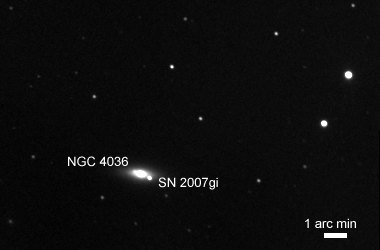 |
| Annotated CCD Image 5 x 120s exposure (average combine), 2x2 binning, C Filter, Linear Scale 2007-08-13 22:13 hUT (#204071-75) |
|
NGC 4036 with SN 2007gi - detail |
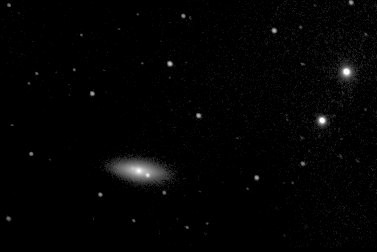 |
| CCD Image - Log Scale Image details as above |
|
|
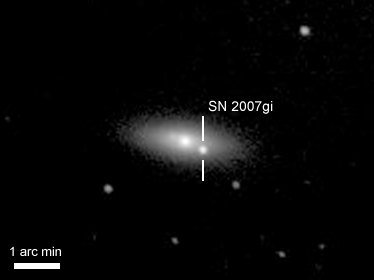 |
| CCD Image - Log Scale (200% size,
cropped) Image details as above |
Back to Top
Baseline images of HAT-P-3 parent star (GSC 3466:819) were acquired as part of a a future project to attempt to detect the transit of an exosolar planet using my 8" LX200 scope. HAT-P-3 was only recently discovered (Torres et al, 2007, http://exoplanet.eu/papers/torres_2007.pdf ). It rotates around its host star in ~ 2.9 days, and has a reported transit time of 2.06 hours.
| HAT-P-3 Parent Star / GSC 3466:819 (Ursa Major) |
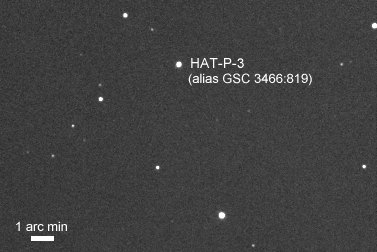
|
|
Annotated CCD Image 3 x 30 sec exposure (median combine), 2x2 binning, C Filter 2007-08-13 22:25h UT (#204079-87) |
| Reference Stars |
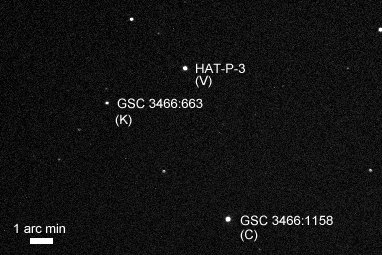
|
|
Annotated CCD Image 60 sec exposure, 2x2 binning, R Filter 2007-08-08 13 22:32h UT (#204091) |
Back to Top
Baseline images of TrES-3 parent star (GSC 3089:929 ) were acquired as part of a project to attempt to detect the transit of an exosolar planet using my 8" LX200 scope. TrES-3b was recently discussed to orbit this star. (TrES team, 2007, http://xxx.lanl.gov/PS_cache/arxiv/pdf/0705/0705.2004v1.pdf )
| TrES-3 Parent Star / GSC 3089:929 (Hercules) |
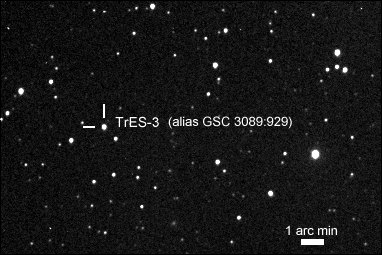
|
|
Annotated CCD Image 3 x 60 sec exposure (average combine), 2x2 binning, C Filter 2007-08-13 23:02h UT (#203194-98) |
| Reference Stars |
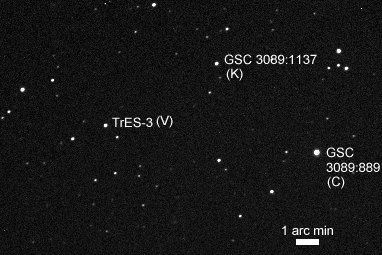
|
|
Annotated CCD Image 60 sec exposure, 2x2 binning, R Filter 2007-08-13 23:07h UT (#204124) |
Back to Top
Attempt made to acquire baseline images of WASP-1 parent star (GSC 2265:107) as part of a project to attempt to detect the transit of an exosolar planet using my 8" LX200 scope. Unfortunately the image centre were not correctly placed and caused the planned Reference star to not fall within the FOV. http://www.blackwell-synergy.com/doi/abs/10.1111/j.1365-2966.2007.11976.x
| WASP-1 (GSC 2265:107) (Andromeda) |
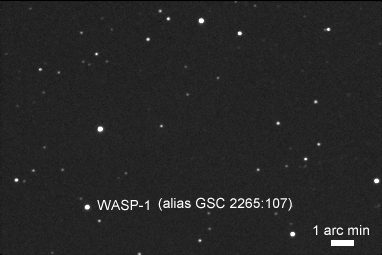
|
|
Annotated CCD Image 3 x 30 sec exposure (median combine), 2x2 binning, C Filter 2007-08-14 00:24h UT (#204224-28) |
Back to Top
Baseline images of WASP-2 parent star (GSC 522:1199) were acquired as part of a project to attempt to detect the transit of an exosolar planet using my 8" LX200 scope. WASP-2b was recently discussed to orbit this star.
| WASP-2 (GSC 522:1199) (Delphinus) |
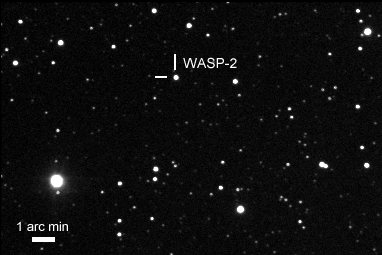
|
|
Annotated CCD Image 3 x 60 sec exposure (median combine), 2x2 binning, C Filter 2007-08-14 00:32h UT (#203232-36) |
| Reference Stars |
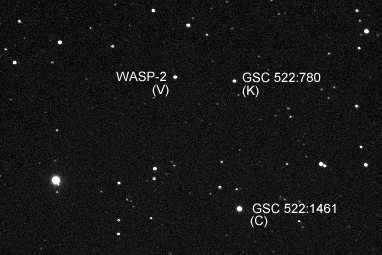
|
|
Annotated CCD Image 45 sec exposure, 2x2 binning, R Filter 2007-08-14 00:30h UT (#204233) |
Back to Top
Polar Alignment Check was made by taking a two baseline/check image pairs separated by 3 minutes (one for a point Due South at Dec 0 deg and a second point approximately Due West and around Dec 16 deg). Results were as follows :
South Sky Point :
Northwards Drift at a rate of 1.64 arc secs/min
(equivalent to Polar Misalignment of
6.28 arc mins in Azimuth,
scope's polar axis needs
turning clockwise by 6.28 arc mins)
West Sky Point :
Northwards Drift at a rate of 0.81 arc secs/min
(equivalent to Polar Misalignment of
3.11 arc mins in Inclination
scope's polar axis needs
raising by 3.11 arc mins)
Polar alignment is not off by far, but benefits
would come from improving it.
Aim is to improve Polar Alignment to
allow longer image exposures (for gallery image) and to help reduce errors
associated with high precision photometry of exoplanet transits. The later will
require stars to be maintained on the CCD images at the the same pixel location.
Autoguiding between frames will be utilised to help maintain stars at fixed
positions, but precise polar alignment will help reduce errors associated with
small but still significant field rotation. Too help ensure the operation
goes smoothly, further checks will be made, ahead of making a final
Polar Alignment Refinement attempt.
Back to Top
Images collected for Astrometric Monitoring
of Nearby Stars Project
Images collected for Photometric Monitoring
of Variable Stars
Back to Top
| This Web Page: | CCD Images - Session 204 (2007-08-13) |
| Last Updated : | 2015-05-16 |
| Site Owner : | David Richards |
| Home Page : | David's Astronomy Web Site |